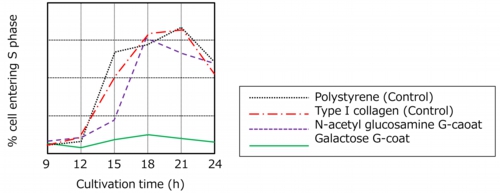Related informations of Neoglyconoid
2021-10-12
Cell Cultureware modified with Neoglyconoid
- NeTech's Neoglyconoid is glucide-carrying polystyrene (G-CPS) composed of styrene monomer introducing oligosaccharides. Naturally occurring glucides are nonadhesive, but G-CPS becomes adhesive to solid supports such as a glass or plastic. After treating with G-CPS the surface of solid supports is covered with abundant carbohydrate moieties, and then becomes strongly hydrophilic.
- [Extra-cellular matrix (ECM) model]
- The normal cells require the adhesion between cell and cell or cell and ECM for their proliferation. ECM is composed of basement membranes including collagen group, non-collagenous glycoprotein group such as fibronectin, vitronectin, laminin, and so on, elastin group, and proteoglycans such as heparin, hyaluronic acid and so on. Therefore, the combination of these substances becomes a model of ECM to cultivate cells. The cell-culture ware can be dually coated with collagen and HCPS. On the surface of culture ware, collagen promotes cellular proliferation and HCPS provides growth factors (GFs) to cultured cells by immobilizing GFs via the heparin moieties.
- As a result, the proliferation of cells which interact with GFs on the dish accelerates at the same level as the case that GFs are directly added to culture medium. When cells attached on the dual coat dishes immobilizing GFs are cultivated by the medium containing other GFs or cytokines, the cells will receive independently discrete stimulation from the apical and basal domain.
- (J Biomed Mater Res. 2001:56(4);536-544)

- [Receptor-mediated cell adhesion]
- Parenchymal liver cells or NK cells are well-known mammalian cells expressing asialoglycoprotein receptors (Artificial Organs. 33(6):419–424) or CD161 to interact with galactose moieties. Thereby G-coat wares modified with the galactose-carrying polystyrene (Gal-CPS) contribute to preferential adhesion of these cells.
- [Modulation of cell cycle]
- G-coat involving galactose moieties has tendency to suppress cellular proliferation. G-coat wear modified with Gal-CPS may be applicable to the induction of cellular differentiation.
 3T3 cells were cultivated on G-coat dishes. The percentage of cells entering S phase IIIIwere estimated from the patterns of fluorescence intensity corresponding with BrdU IIIIuptake.
3T3 cells were cultivated on G-coat dishes. The percentage of cells entering S phase IIIIwere estimated from the patterns of fluorescence intensity corresponding with BrdU IIIIuptake. The graph shows that most of the cells cultivated on G-coat dishes with galactose IIIIdid not enter S phase.
The graph shows that most of the cells cultivated on G-coat dishes with galactose IIIIdid not enter S phase.

Application to medical device
- The styrene monomer introducing glucides is easy to covalently immobilize to solid supports.
- [Immobilization of HCPS]

- Column packed with the solid supports immobilizing HCPS enables adsorption, removal and detection of heparin-bindable substances such as growth factors, cytokines, and so on.

- [The candidates for an application]
- Plasma apheresis in the direct hemoperfusion
 Ulcerative colitis
Ulcerative colitis Hypercytokinemia
Hypercytokinemia Hyper cholesterolemia
Hyper cholesterolemia
- Detection of heparin-bindable substances
 Inflammatory Bowel Disease: IBD
Inflammatory Bowel Disease: IBD
- In recent years, the current number of Ulcerative Colitis (UC) patients is regarded as at least 100,000 people. The number of the patient increases at the ratio of approximately 4,000 people a year. UC together with Crohn disease is also called Inflammatory Bowel Disease (IBD).
- IBD is a chronic and revived immune-disease occurring in complex factors. In general, the suppression of a hypersensitive immune reaction and inflammation by administering steroid or performing leukocyte apheresis leads to the treatment of IBD.
- In the case that the steroid does not improve IBD, cytapheresis (CAP) targeting granulocytes is positively performed. CAP involves that granulocytes or lymphocytes are preferentially removed by adsorbing to cellulose acetate beads or polyester nonwoven.
- It is known that these treatments reduce IBD-promoting cytokines such as TNF, IL-1β, IL-6, IL-12, IL-8, IL-4, IFN-γ, and enhance inhibitory cytokines IL-10, TGFβ, IL-1ra, IL-13 or inhibitory chemical mediators PGE2 and PGJ2. Extracorporeal perfusion by using adsorbents immobilized with HCPS will decrease the concentration of the promoting cytokines, and then may improve IBD.
- It has been reported that GCAP is approved as treatment for not only IBD but also rheumatoid arthritis, Behcet's disease and systemic lupus erythematosus in Europe, and that GCAP is applicable to ANCA-related vasculitis and severe alcoholic hepatitis.
 Hypercytokinemia
Hypercytokinemia
- In recent years, sepsis is defined as systemic inflammatory response syndrome (SIRS) caused by infection. It is widely admitted that excess cytokines produced from immunocompetent cells cause sepsis. In severe septic shock and severe sepsis, hypercytokinemia that persists high blood concentration of cytokines causes respiratory failure and shock, renal injury, and DIC, and then gives rise to fatal multi-organ failure (MOF).
- It was thought that the concentration of inflammatory cytokines was correlated with severity of MOF. Thus, in order to improve life-saving ratio the persistent removal of cytokines by using filtration is attempted. Polymethyl methacrylate membrane to non-specifically adsorb cytokines is used to continuous hemodiafiltration (CHDF) leading to disengagement from a shock through reducing the blood concentration of IL-6 related to MOF.
- The heparinized adsorbents enable to selectively adsorb all sorts of cytokines. Therefore the adsorbents modified with HCPS will be promising as CHDF.

 Contact US
Contact US
 Home
Home Related informations
Related informations